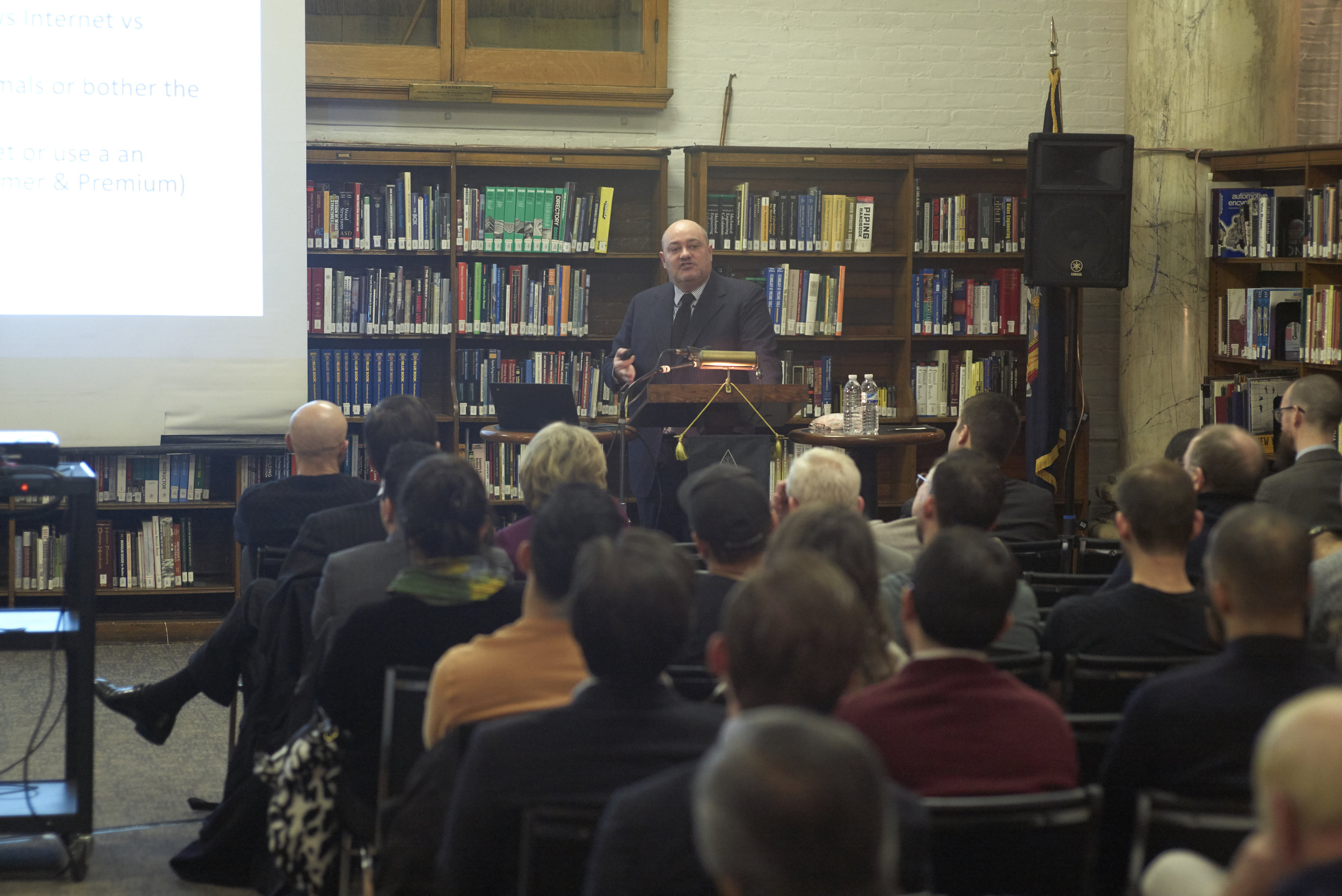
The Horologist’s Loupe
The Horological Society of New York's newsletter (and today blog!) began publishing in 1936, and is one of the oldest continuously running horological publications in the world.
HSNY Visits Local Schools to Speak with Students About Horology
HSNY's President, Nicholas Manousos, and Executive Director, Ed Hydeman, recently visited two schools in New York City as part of HSNY's ongoing Outreach Program. On Monday, March 12, 2018, the duo visited P.S. 62 in Queens for their Career Day, where they spoke with 135 fourth graders in the school's auditorium. The following Wednesday, March 14, 2018, the duo visited The Riverdale Country School in the Bronx and spoke with a class of middle school students who were in the middle of an experiential study program on horology.
The study of time is an incredibly diverse subject, covering history, art, mathematics, astronomy, physics and more. Horological education provides a foundation for students as they continue their studies in other subjects, and introduces an in-demand career option. The Horological Society of New York's staff of professional watchmakers and horological historians are available for classroom visits, career days and speaking engagements, free of charge. Contact us today to arrange a visit to your school!
Meeting Recap: Horological Conservation - A Preliminary Study of Bellows Materials in Smoking Automata
Video recordings of meetings are available to HSNY members.
Brittany Nicole Cox, Antiquarian Horologist, Seattle, Washington
March 5, 2018
The great George Daniels said, “Mechanical watches are historical, intellectual, technical, aesthetic, useful, and amusing.” While many of us can agree with the first five points, the last one might be a bit befuddling. But automata combine all of these features in a way that still remains fresh and exciting. At the March 5, 2018, lecture of the Horological Society of New York, Antiquarian Horologist Brittany Nicole Cox, of Memoria Technica in Seattle, gave a lecture on a specific type of automata: smoking automata.
Before she delved into these fascinating figures, Cox described the intricacies of automata and the importance of horological conservation. More than just telling time, automata serve a function, and Cox’s main concern is preserving that function along with the historical integrity of the piece she is working on—no matter how complicated that task might be. Clocks with automata figured and singing bird boxes (some actual taxidermy birds with mechanical innards) are some of the horological figures Cox works on.
Cox’s lecture on smoking automata powered by bellows was presented as a way to promote conservation research into materials. These intricate and complex machines often pose a particular set of problems for the conservator. Damage through performance and natural degradation, the use of mixed materials, even the use of the bellows themselves, can all contribute to an automaton’s degradation over time. The cigarette smoking automata were made in the Marais District of Paris between 1848 and and 1914. In addition to being made of materials like textiles, leather, paper, wood, and clockwork innards, these automata also smoked real cigarettes. Cox did her study on an automaton made in the workshop of Gustav Vichy. The automaton wears a red coat, white trousers, and leather boots—all which needed to be removed in order to expose the bellows beneath.
When operated, the clockwork mechanism pumps the bellows in time with the motions of the figure. The head moves from left to right, the eyes blink, and the mouth is open to draw cigarette smoke into it. Upon exhalation, the arm is lowered, and the mouth is opened, exhaling the smoke. The monocle is raised to the right eye and the figure blinks through it. A tube inside the automaton’s hand, connecting it to the chest, draws the smoke in, and another tube draws the smoke back to the mouth. Historicall, components of the bellows system were made from alum-tawed skin and vulcanized rubber, which can become brittle and prone to breakage. In order to work, however, bellows must be flexible, strong, and airtight. This poses a unique problem to the restorer. To construct their replacement, Cox elected to use Tyvek, a modern material that is chemically stable, durable, flexible, durable, strong, and airtight. Cox undertook three trials, exposing the Tyvek bellows to smoke and tensile testing. To repair the damage to the head, Cox used Japanese tissue and wheat paste.
HSNY thanks Brittany Nicole Cox for her fascinating lecture!
Submitted by Christa Chance, Recording Secretary, HSNY




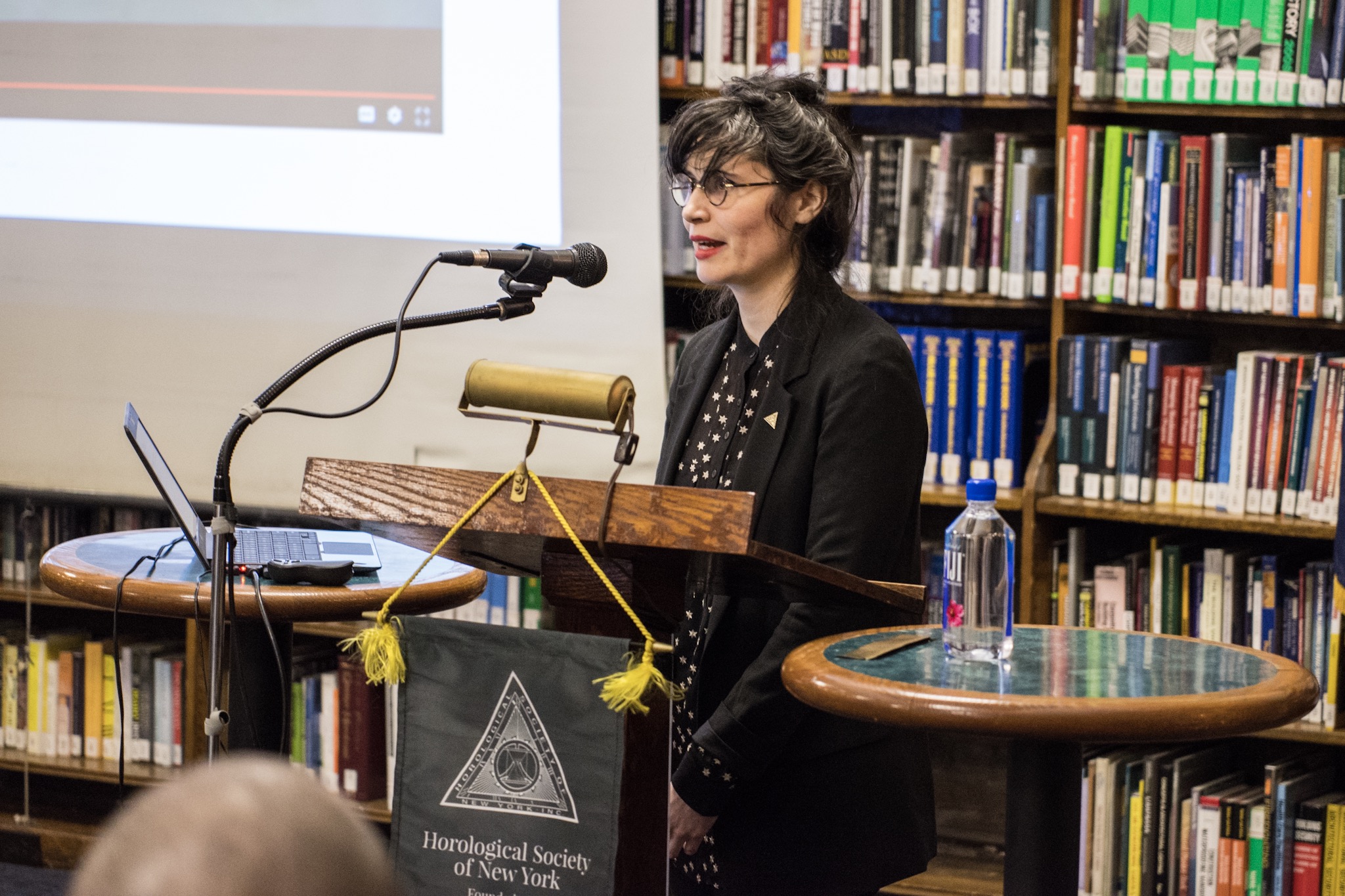






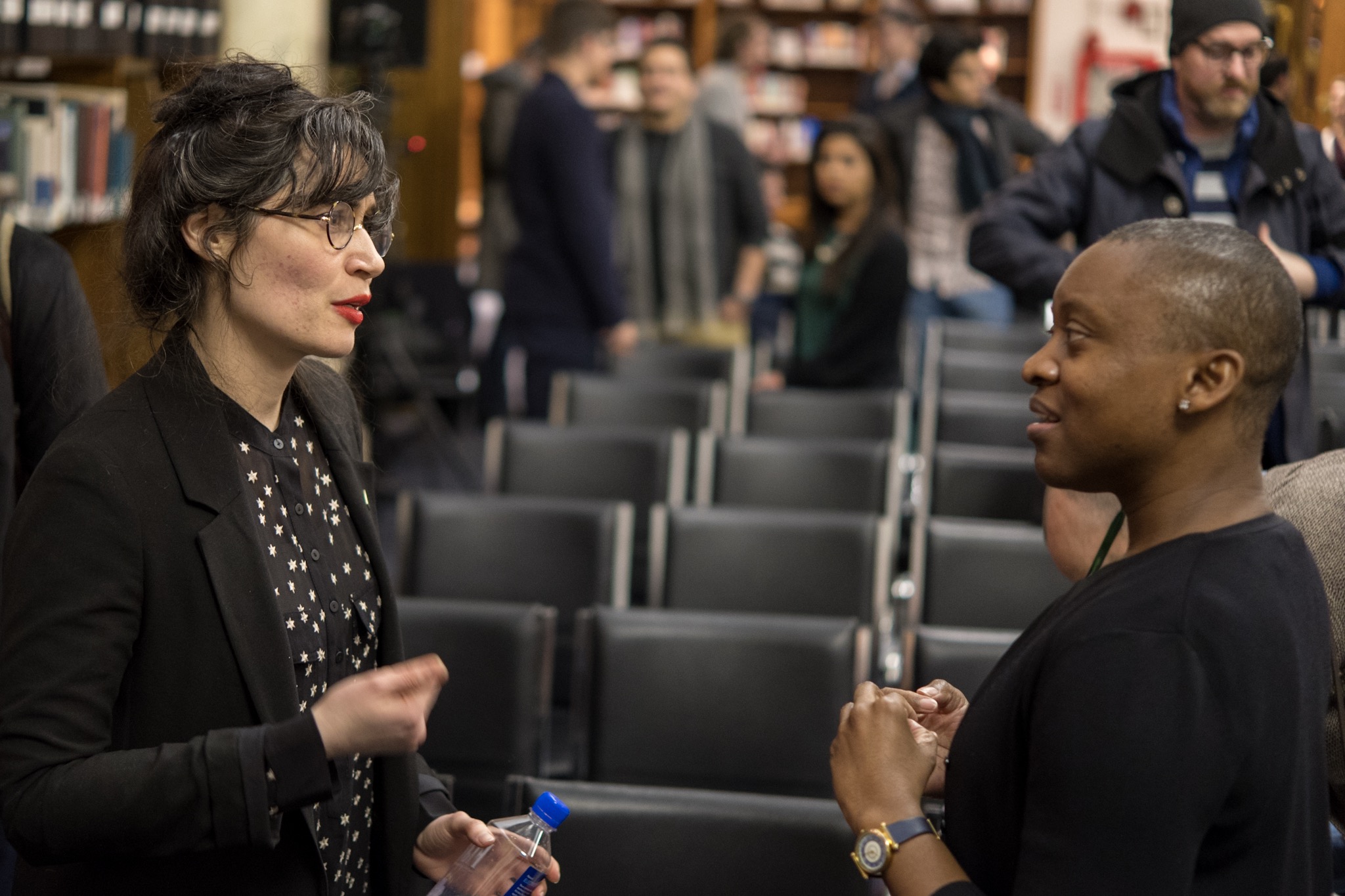

Meeting Recap: The Essentials Of Precision Timekeeping
Jack Forster, Editor-in-Chief, HODINKEE
February 5, 2018
Video recordings of meetings are available to HSNY members.
Ever since the dawn of time, mankind has tried to keep track of it. Although timekeeping devices have evolved, from the water clocks of antiquity to the atomic clock today, the general principle behind them is the same: that they be correct. At the February 5, 2018 lecture before the Horological Society of New York, Jack Forster, Editor-in-Chief of HODINKEE, traced the origins of precision timekeeping, and delved into what makes it work. The first step in understanding precision timekeeping is to understand the difference between precision and accuracy. While we often conflate the two, they are in fact quite different. In the simplest terms, accuracy is the conformity to a time standard. However, in horology, precision refers to rate or frequency stability. For a timekeeper to be precise, it must have a stable rate.
Early efforts to track the procession of time relied on continuous processes, such as the movement of heavenly bodies or the flow of water. An example of an early timekeeper that tells time from the movement of a heavenly body is, as one might expect, a sundial. Ancient Greeks told time with water clocks, which could have been as simple as a bowl of water with lines drawn on the inside. As time progressed, timekeeping devices became more sophisticated. This brings us to the second method with which time is measured: oscillatory processes. An example of this would be the swinging of a pendulum in a longcase clock.
A pendulum is a harmonic oscillator, in which a mass, such as a weight, experiences a restoring force proportional to the driving force. Harmonic oscillators have a natural frequency which makes them suitable for timekeeping. In a pendulum, the restoring force is gravity, which is constant at a given altitude, making it ideal for timekeeping. This is achieved in modern watches and clocks by the escapement. For all our advances in horology, modern timekeepers are still plagued by the same issues that our ancestors dealt with. Temperature, magnetism, positional variation, and changes in atmospheric pressure can affect accurate timekeeping. The essence of modern horology, therefore, is combating these elements in order to keep timekeepers accurate... and precise.
HSNY thanks Jack Forster for his fascinating lecture!
Submitted by Christa Chance, Recording Secretary, HSNY







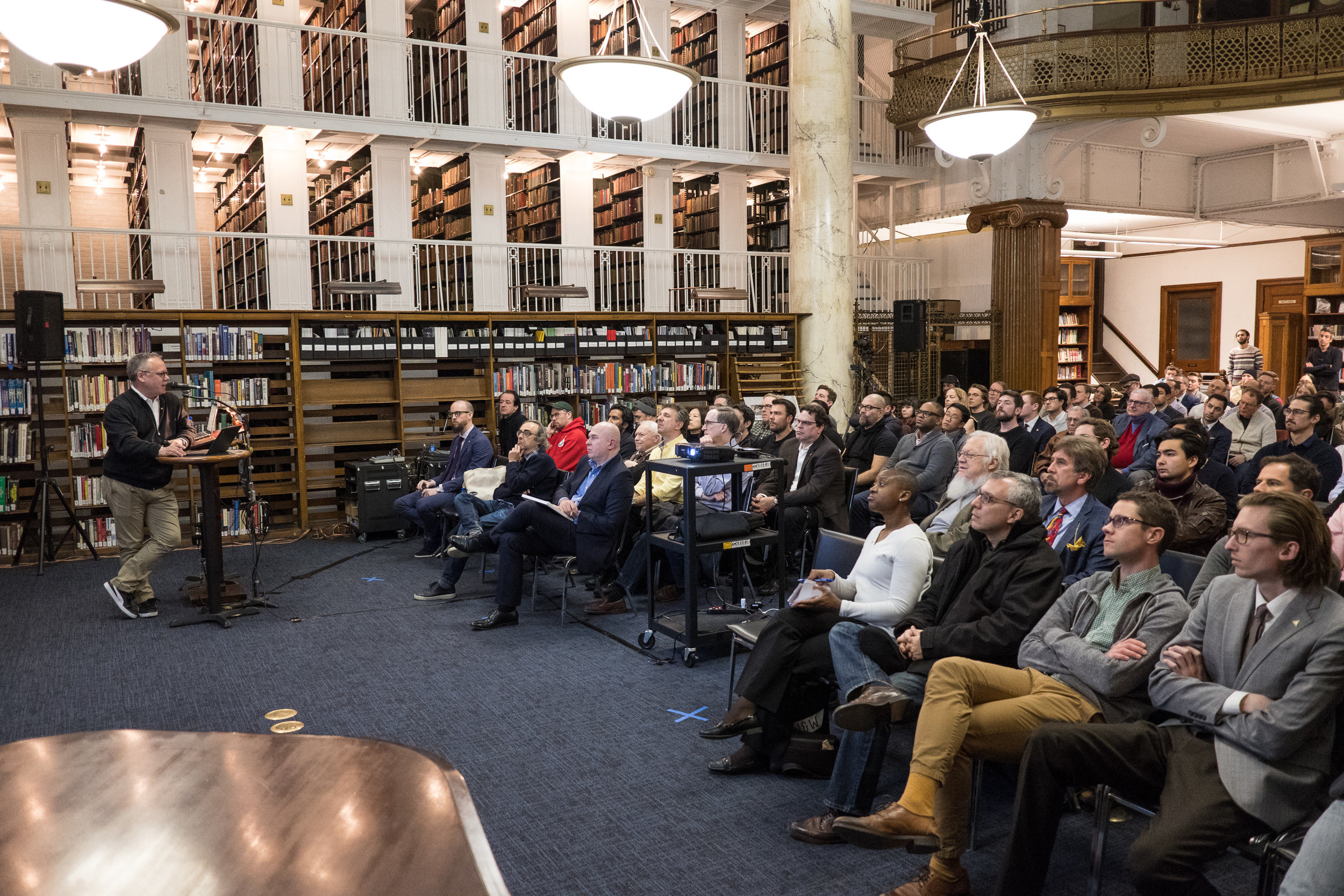

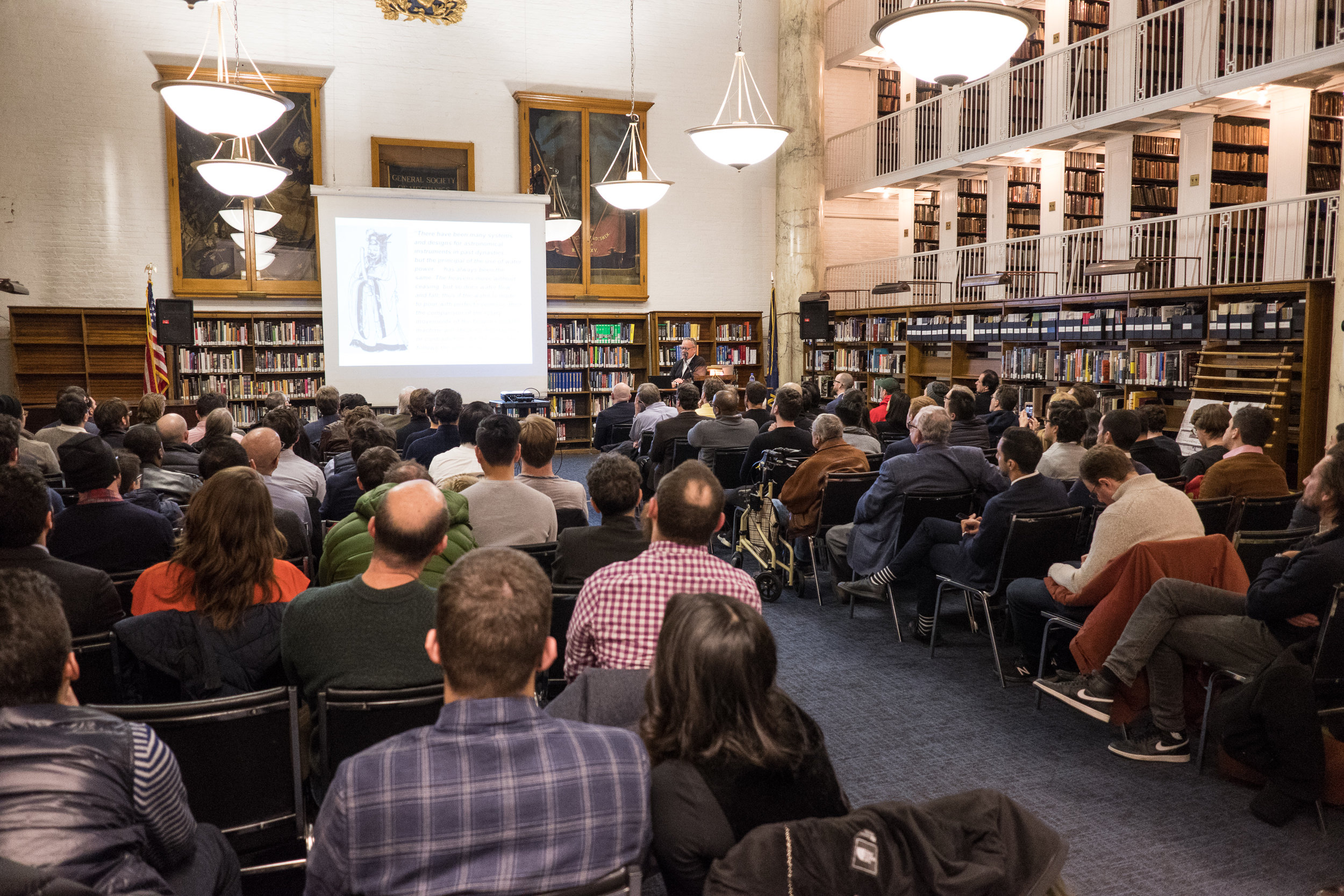



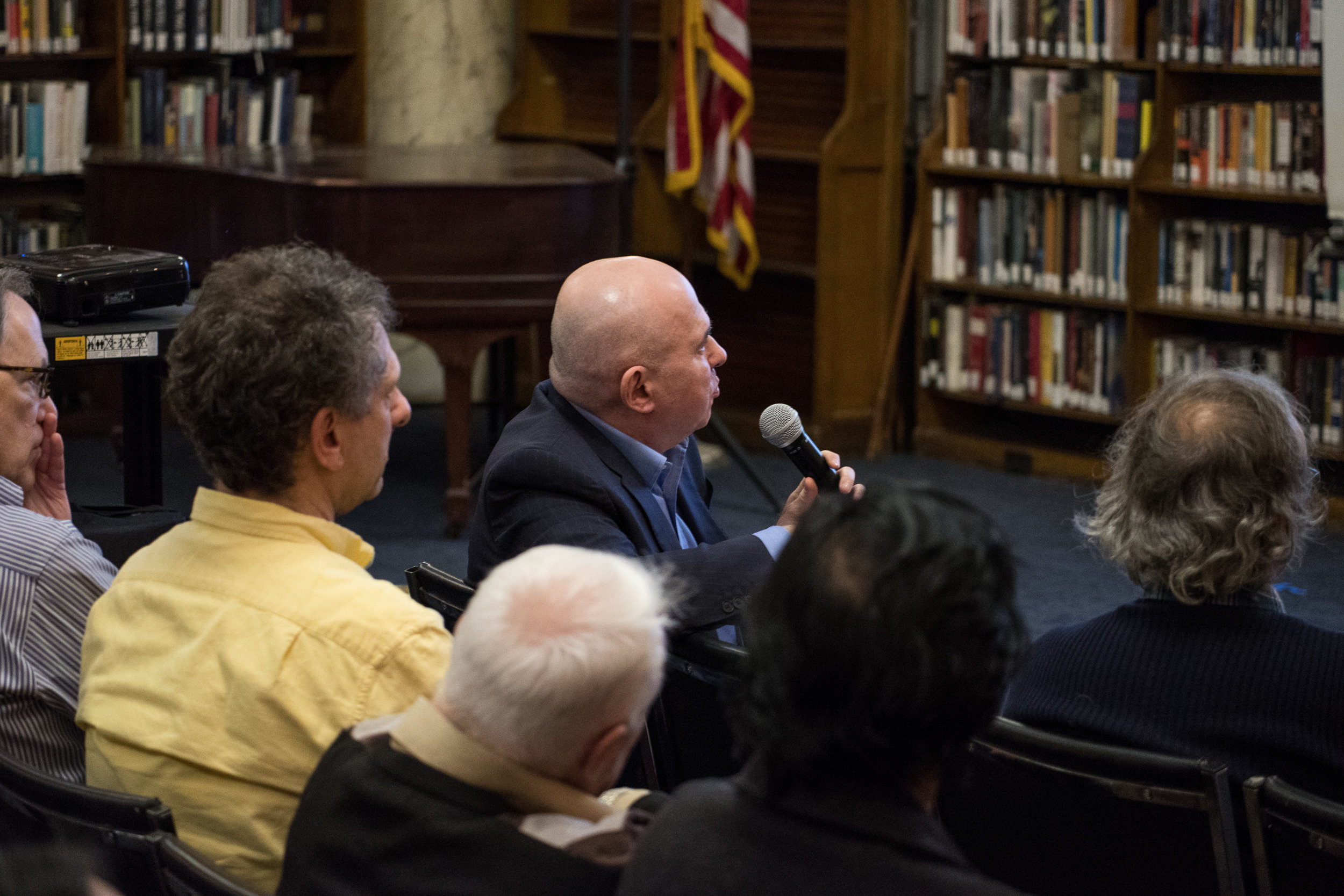

Meeting Recap: An Introduction to the Naked Watchmaker Platform
Peter Speake-Marin, Founder, The Naked Watchmaker, Switzerland
January 9, 2018
Video recordings of meetings are available to HSNY members.
For the first HSNY meeting of 2018, noted watchmaker Peter Speake-Marin spoke at about his new project, The Naked Watchmaker. The Naked Watchmaker is a website devoted exclusively to pursuing horological education. In Speake-Marin’s own words, he intends to "bring to a new generation the magic and passion of watchmaking, and to increase the knowledge of those already bitten by the horological bug." As a veteran watchmaker, Speake-Marin has garnered extensive experience with the inner workings of the Swiss watchmaking industry. He spent several years in after-sale service, restoration, building complicated movements, product development, training, and developing companies. The Naked Watchmaker is a fulfillment of a lifelong goal for Speake-Marin.
The Naked Watchmaker covers information in six categories, offering insight on areas that collectors will experience in pursuing their passion. For example, many collectors start with the first category, pocket watches, but might find that they are tricky to service due to the age and obscurity of many of the parts. Collectors of vintage watches, the second category, might run into the same issues; moreover, due to the fact that certain features of vintage watches—that might be considered damage by watchmakers—can in fact be considered valuable. Even collectors of watches made by modern independent brands, the third category, run into their own unique challenges due to the fact that many watches created by independent brands can be one-of-a-kind pieces.
For the fourth category, "just movements", The Naked Watchmaker intends to bring insight to the unique and obscure features that many historical movements possess. The same holds true for modern calibres, the fifth category that The Naked Watchmaker covers, because many are only serviced by large brands. Finally, Speaks-Marin intends to offer horological art, the sixth category, on his platform. In the future Speake-Marin intends to continue to populate the site and make it a "Wikipedia for watches." Future sections include: modern machining techniques, how watches work, books (both paper and electronic), recommendations for museums and schools, and videos made in collaboration with Watches TV.
HSNY thanks Peter Speake-Marin for his fascinating lecture!












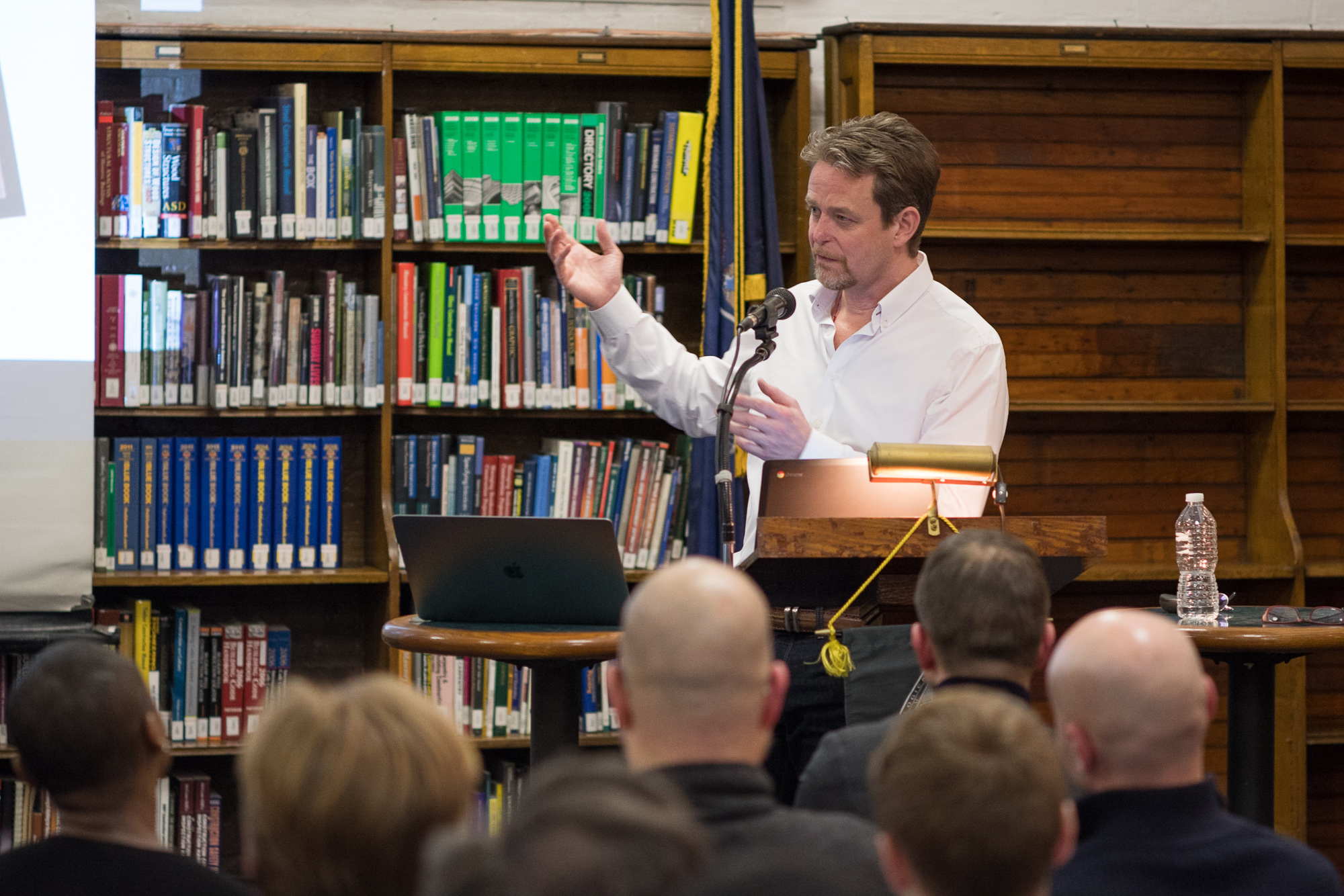



Hans Weber, 1932-2018
Hans Weber died on the morning of Saturday, January 6, 2018. Hans was an active member of the Horological Society of New York for over 50 years, and was the only person to have attended both the 100th Anniversary in 1966 and 150th anniversary in 2016. Hans served as a Trustee for the Society, and was presented the Howard Fass award at the 150th Anniversary for his extraordinary dedication to the Society's ideals. Hans worked at both Cartier and Tiffany & Co. in New York. He was a kind man, a talented watchmaker, and he will be missed.
Service Information
Saturday, January 13, 2018
Visitation beginning at noon, service offered at 2:30pm
Vander Plaat Funeral Home
257 Godwin Avenue
Wyckoff, NJ 07481
201-891-3400
Henry B. Fried Scholarship for American Watchmaking Quadrupled for 2018
Henry B. Fried teaching a watchmaking class.
The Horological Society of New York’s Henry B. Fried Scholarship was established in early 2017, with a goal of increasing the number of students studying at full-time watchmaking schools in the USA. Most watchmaking schools in the USA are free, but the cost of living while attending school can be a large barrier for prospective students. Additionally, many watchmaking schools are not accredited, meaning student loans are not possible. At the same time, watchmakers are more in-demand than ever. The popularity of mechanical watches continues to increase, but more watchmakers are retiring than graduating. With the Henry B. Fried Scholarship, the Horological Society of New York (HSNY) is working diligently to reverse that trend, by offering significant financial assistance to American watchmaking students.
The dramatic expansion of the Henry B. Fried Scholarship was made possible by an incredibly generous and anonymous donation of $100,000, shortly after Roger W. Smith’s lecture in December 2017. For 2018, the Henry B. Fried Scholarship will quadruple from one award of $5,000 to two awards of $10,000 each. The application period is open now through March 1, 2018, and the scholarships will be awarded at HSNY’s annual Gala & Charity Auction on April 18, 2018. Students who are either studying at or have been accepted to a full-time watchmaking school in the USA are eligible. To apply, students should write a letter to HSNY that includes a brief biography and explanation of their motivation to study watchmaking.
Meeting Recap: The Development of a Practical Watch Escapement
Roger W. Smith, Founder, Roger W. Smith Ltd., Isle of Man, British Isles
December 4, 2017
No one knows who invented the escapement, but it has been contributed to over the centuries by generations of talented watch and clock makers. Even so, only a few have ever been practical for daily use in a watch. On December 4, 2017, Roger W. Smith lectured at the Horological Society of New York and spoke on the practicality of the co-axial escapement.
In his lecture, Smith explained that he had been able to dramatically increase the service interval of his watches due to the efficiency of the co-axial escapement. He then extrapolated on his mentor George Daniels’s research in escapement development, which resulted in the publishing of The Practical Watch Escapement in 1994.
Early escapements, like the cylinder, exhibited sliding friction while operating. Detached escapements reduced sliding friction, allowing the balance to run freely and reducing the stress on the already heavily taxed escapement lubrication. The more a balance is able to swing freely, the more accurately the watch can run, and with a longer service interval. Even modern detached escapements, like the lever, still exhibit a high amount of sliding friction.
There have been many escapement designs that have come close to eliminating sliding friction, but nearly all of them are limited by the higher complexity and therefore higher failure rate and cost to manufacture. Daniels' co-axial, and Smith's single wheel co-axial escapement provides power much more efficiently than a Swiss lever escapement, and has reduced reliance on lubrication in order to operate, all while being practical to implement in a wristwatch.
The Sunday before Smith's lecture at HSNY, he guest instructed a special horological education class for six lucky students. The class was an opportunity for students to learn from one of the world's leading watchmakers, over an afternoon in Brooklyn.
HSNY thanks Roger W. Smith for his fascinating lecture!
Submitted by Christa Chance, Recording Secretary, HSNY

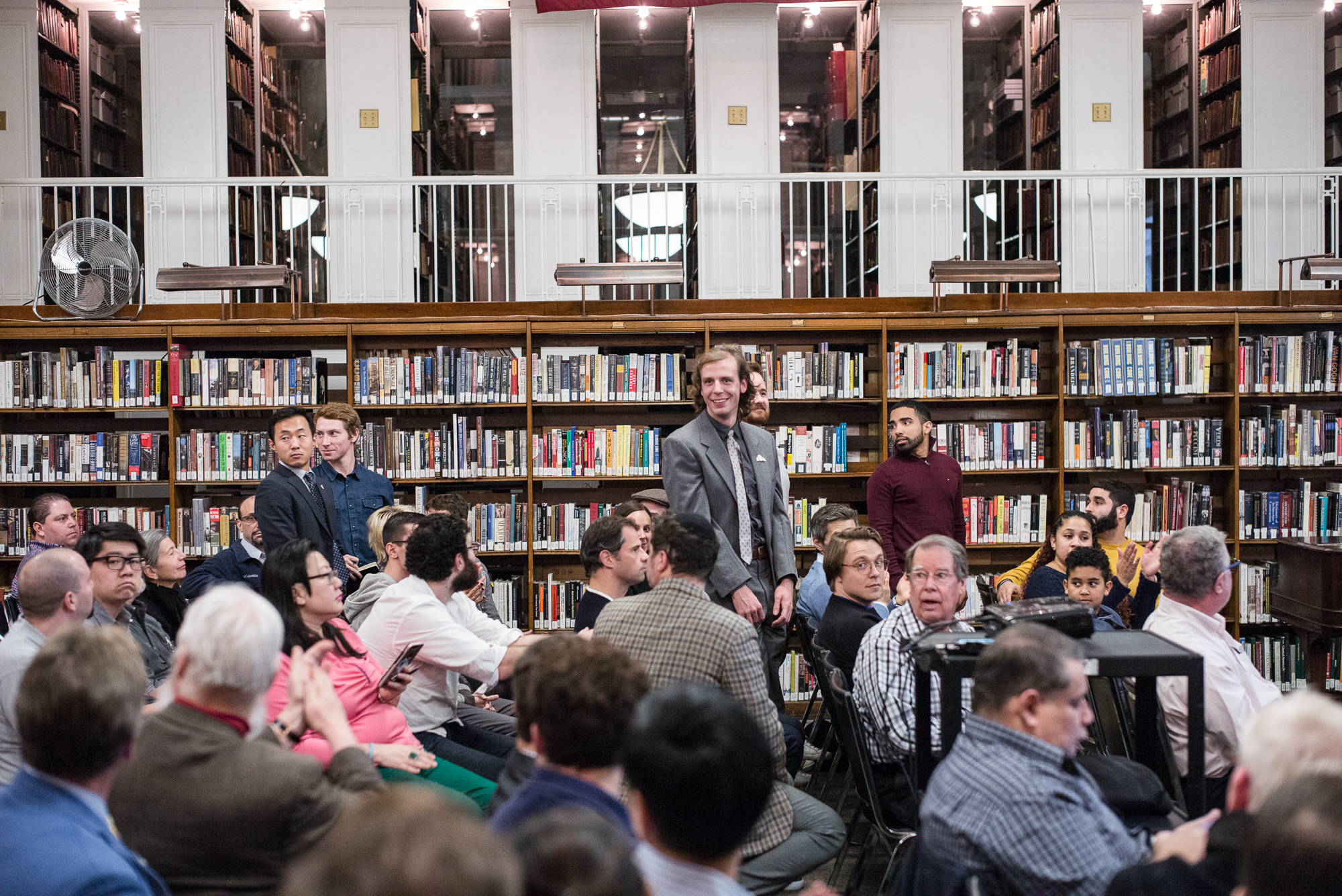

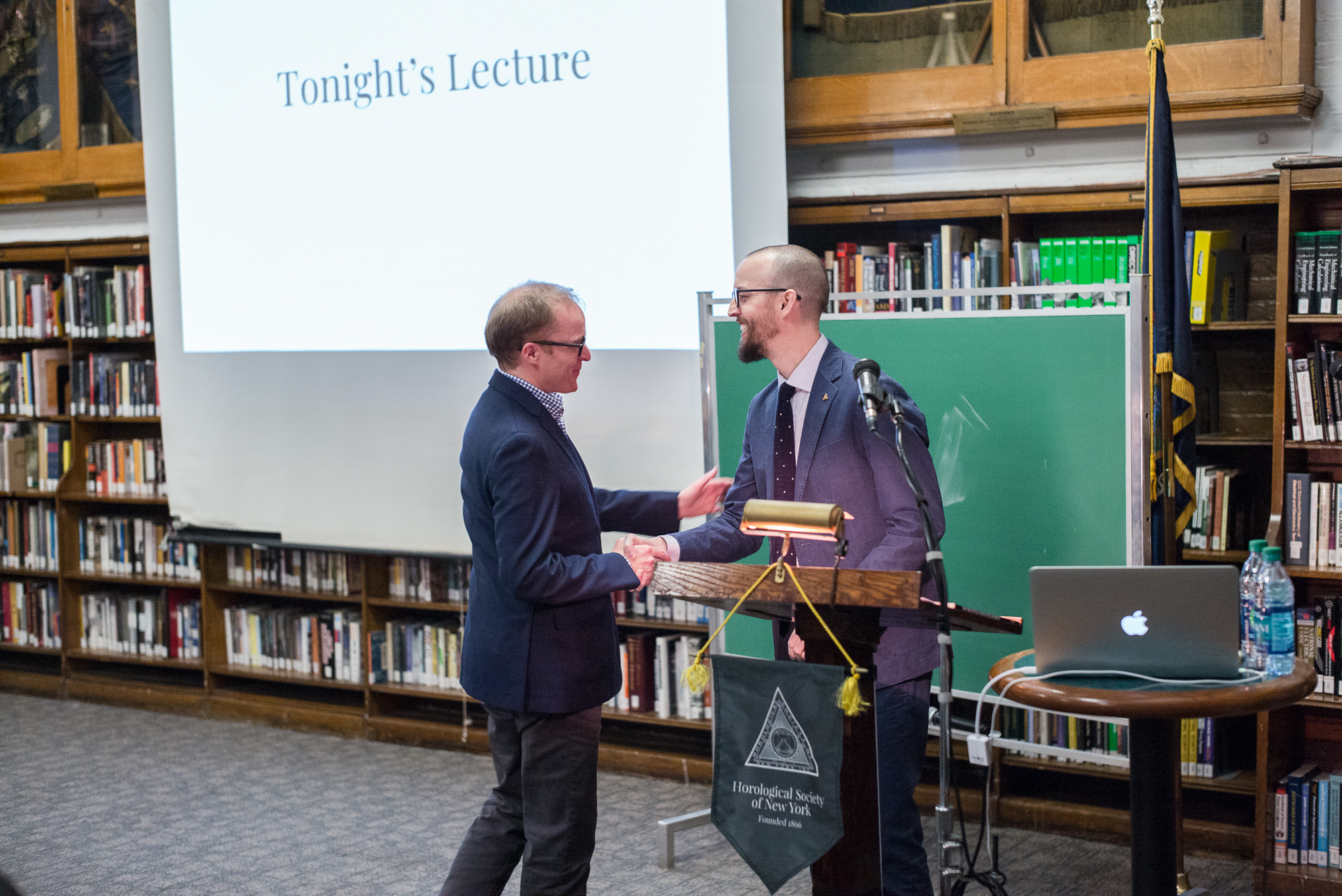









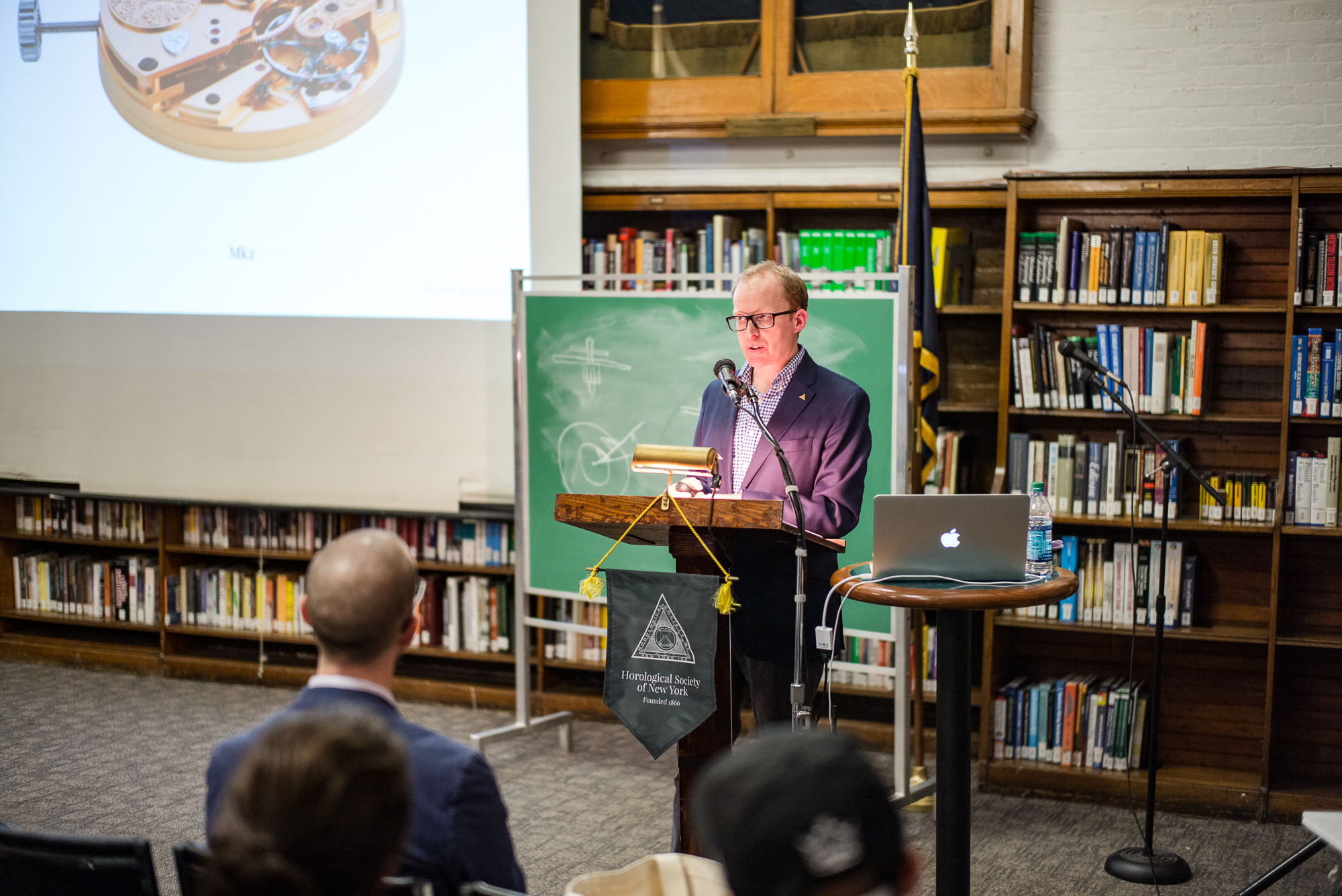



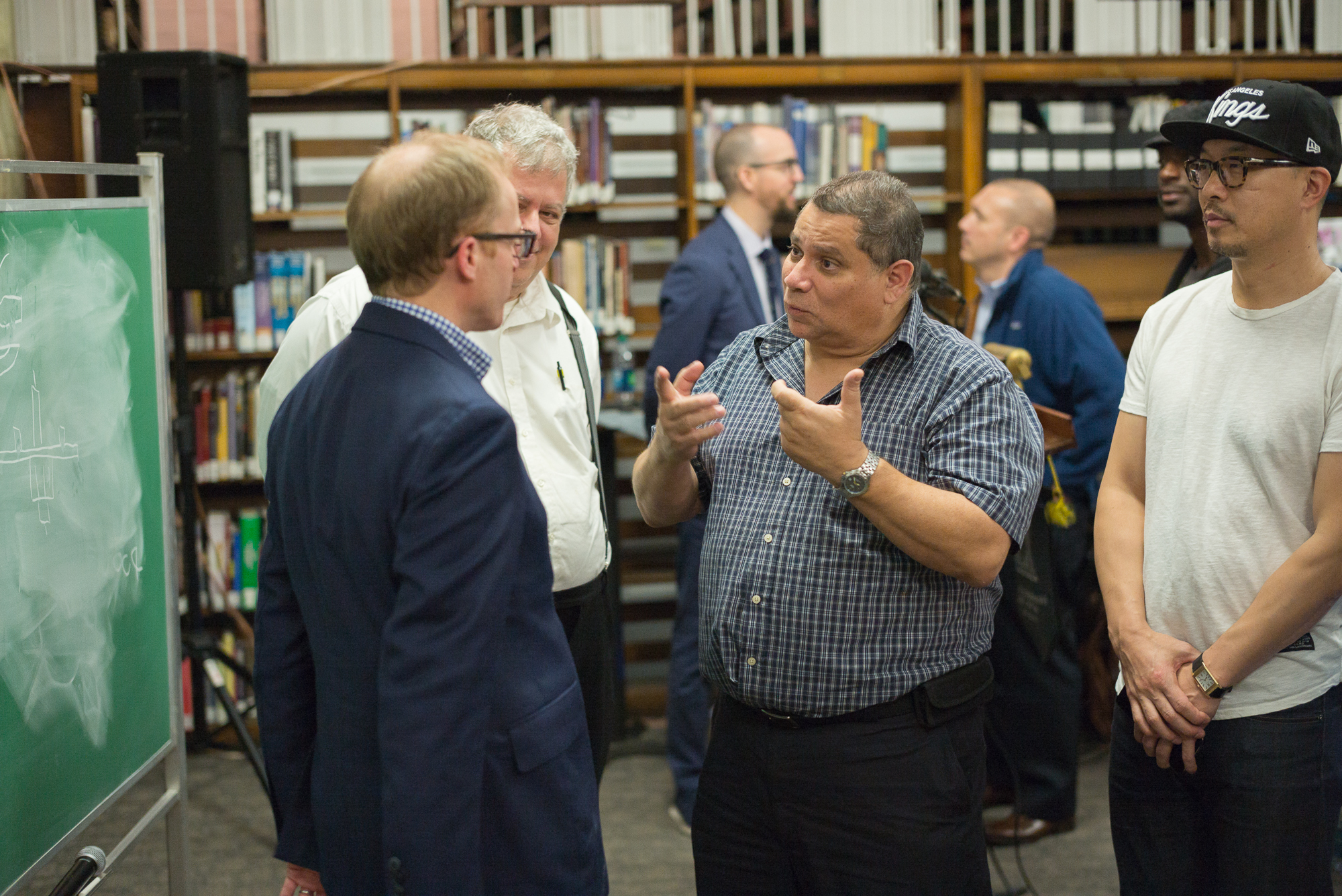







HSNY Welcomes Watchonista as a Sponsor
Watchonista, the online magazine dedicated to covering the world of watches, has joined the Horological Society of New York (HSNY) as a sponsor. Watchonista’s generous support will enhance HSNY’s mission of horological education.
Watchonista's Co-Founders Alexander Friedman and Marco Gabella said “Watchonista is delighted to sponsor the Horology Society of New York. It’s an honor to join esteemed colleagues and partner brands to support this very worthy cause. In addition, we’re committed to globally supporting HSNY's efforts to educate the next generation of watchmakers. We look forward to helping share the association’s knowledge and history to our readers.“
Nicholas Manousos, HSNY President said “Watchonista's passion for horology is evident through their in-depth and intriguing editorial coverage of the watchmaking industry and their support of charitable horological organizations around the world. HSNY looks forward to a wonderful partnership and thanks Watchonista for their generous support.“
Early Bird Tickets Now Available for HSNY's 2018 Gala & Charity Auction
The Horological Society of New York invites you to celebrate its 152nd year at the 2018 Gala and Charity Auction on Wednesday April 18, 2018. The annual Gala and Charity Auction is an opportunity to look back at our accomplishments, recognize talented watchmaking students, and bid on incredible watches and ephemera. More details will be announced soon. Early bird tickets are available only until January 31, 2018. Don't delay, reserve your tickets to HSNY's 2018 Gala & Charity Auction today!
2018 Executive Committee
HSNY's Board of Directors met recently to hold elections for 2018. After serving as Vice President for 2017, Michael Fossner resigned and nominated Luke Cox-Bien as his successor. Luke Cox-Bien was then elected Vice President by HSNY’s trustees. Luke Cox-Bien has been a member of HSNY for five years, and has held several executive committee positions. HSNY thanks Michael Fossner for his exemplary service. In addition, Brett Walsdorf, who serves as Director of Special Events, was elected Trustee.
Pictured above, Nicholas Manousos, President (left), and Luke Cox-Bien, Vice President (right). Photo by Atom Moore.
Meeting Recap: How I Learned to Stop Worrying and Love Radium Dials
Kathleen McGivney, COO, RedBar Group and Director of Operations, Horological Society of New York
November 7, 2017
Video recordings of meetings are available to HSNY members.
Many watch collectors own watches with radium dials - even seeking them out specifically. But do these watches present any dangers to the collectors who wear them? In her lecture to the Horological Society of New York on November 7, 2017, HSNY's Director of Operations and Red Bar's COO Kathleen McGivney delved into the history of radium dials and answered those pressing questions.
Radioluminescence, the process by which light is produced by bombarding a reactive material with ionizing radiation, was widely used as the demand for watches that were readable at night grew. Radium, discovered by the Curies (who coined the term “radioactivity”) in the 1890s, was ideal for that use due to its radioluminescent properties. Also, since radium was viewed at the time to have medicinal benefits (even touted to cure arthritis and high blood pressure), its potential deleterious effects were ignored… to deadly effect.
Starting in the 1910s, thousands of young women began working at factories devoted to producing watches with radium dials. They would dip their camelhair brushes into a solution of radium, and then moisten the tip of the brushes between their lips to give them a finer point. The “Radium Girls” churned out dials, knowing that the watches they painted would adorn the wrists of soldiers fighting “over there” in the First World War.
By the 1920s, the Radium Girls began to fall ill and die of wasting diseases that doctors attributed to their ingestion of the element, eventually filing lawsuits which led to the establishment of OSHA. Which brings us to the present day: since the watch industry used radium until well into the 1950s, many watches with radium dials survive. Are these watches dangerous to handle or wear? The short answer is no.
McGivney shared videos of readings she took with a Geiger counter from watches with radium dials. While all emitted some radioactivity, McGivney concluded that the exposure was not enough to harm the people who wear them. However, McGivney recommended that collectors store these watches in lead-lined pouches.
HSNY thanks Kathleen McGivney for her fascinating lecture!
Submitted by Christa Chance, Recording Secretary, HSNY





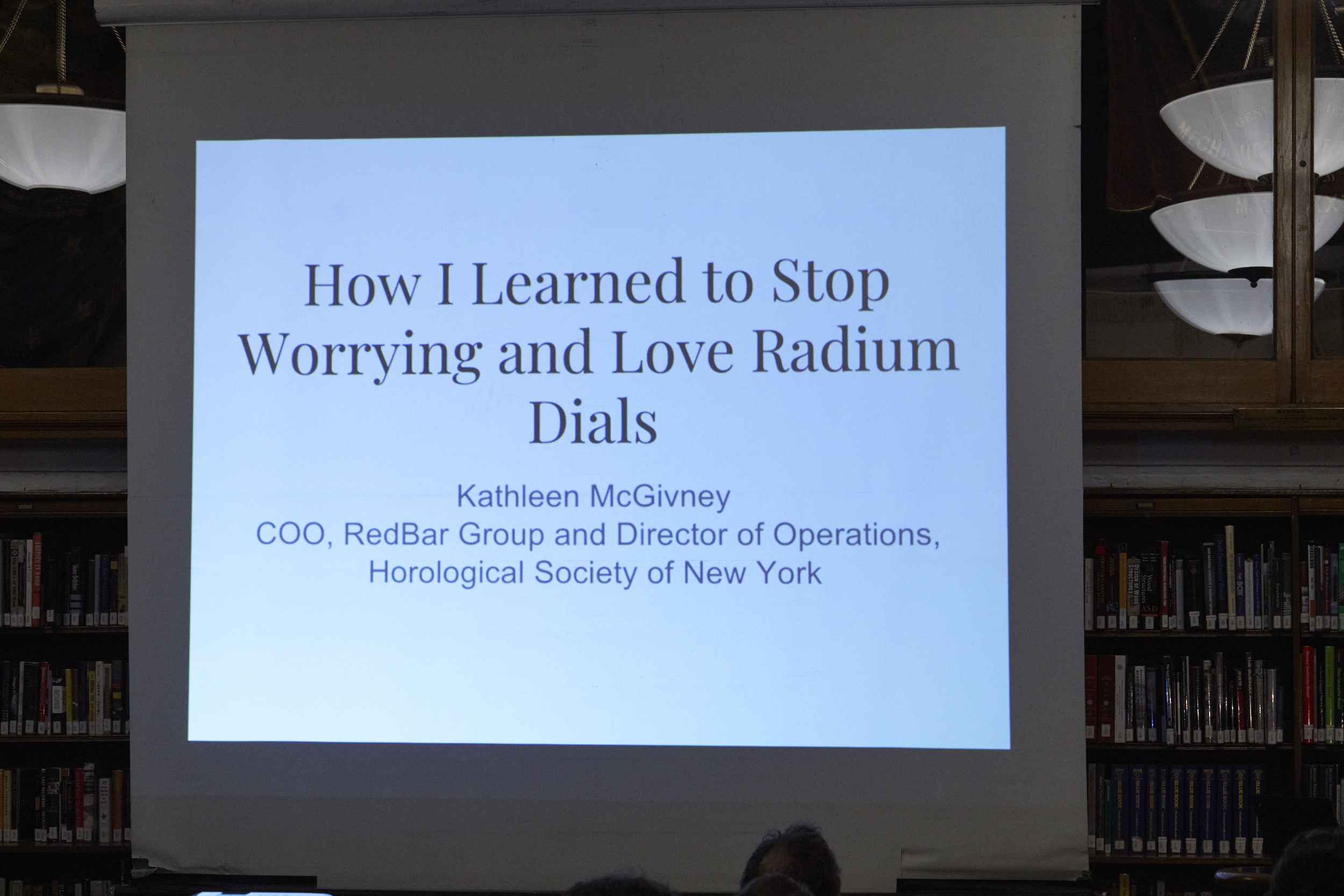





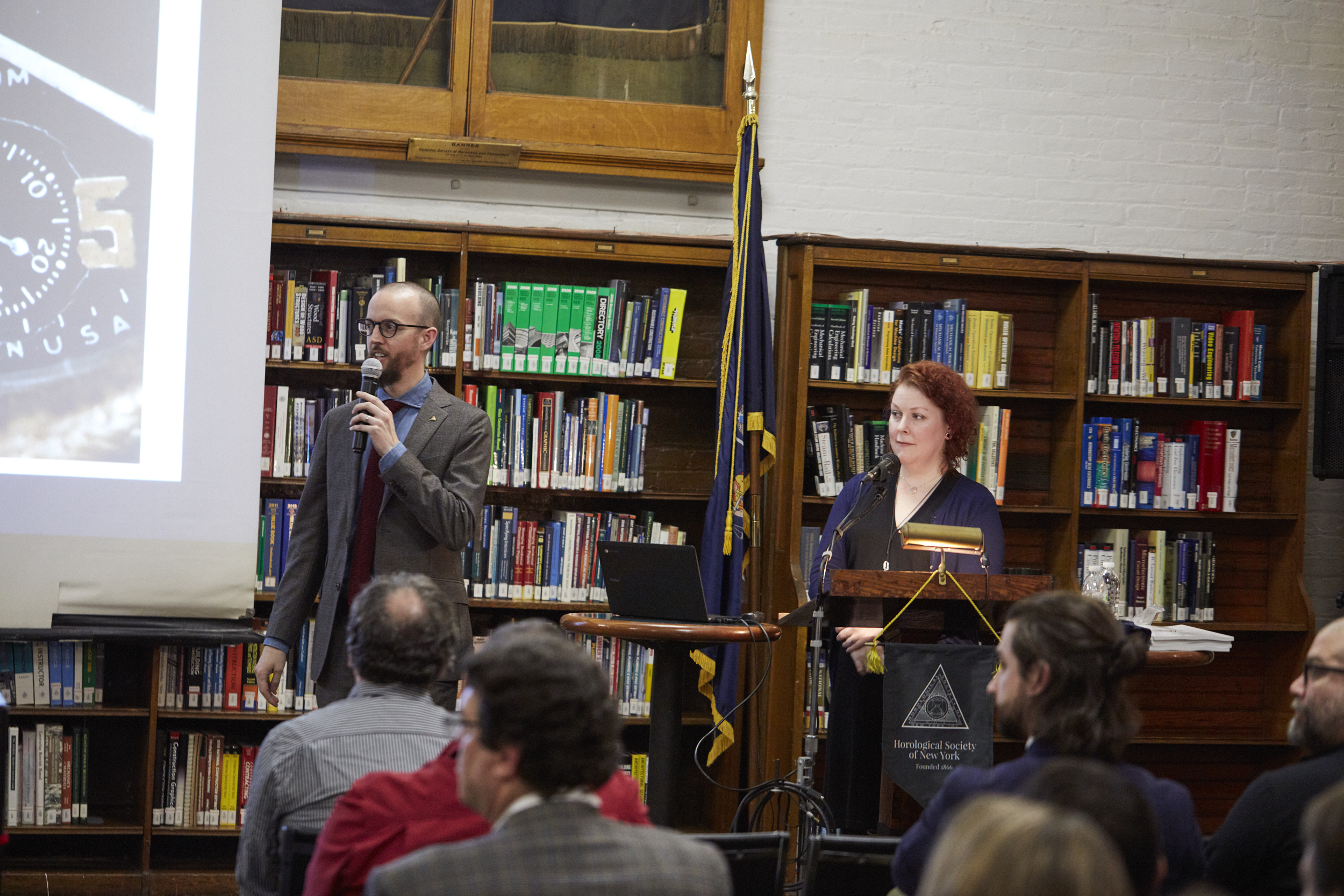


Meeting Recap: Fakes, Forgeries and the Birth of Mass Production in the European Watch Industry, 1750-1820
Dr. Rebecca Struthers FBHI FRSA Ph.D., Birmingham, UK
October 2, 2017
Video recordings of meetings are available to HSNY members.
Anyone who has visited Chinatown in New York has seen the thousands of “imitation” watches on offer. Though it might seem like a product of the age of mass-machining in which we live, such a concept is much older. In her lecture at the Horological Society of New York on October 2, 2017, Dr. Rebecca Struthers, FBHI, FRSA, PhD, Birmingham, UK, discussed her groundbreaking research on 18th-century “Dutch forgeries.”
London was the center of horology in the 18th century. This was the Golden Age of British Watchmaking. Watchmakers like Tompion and Mudge produced roughly 1,000 watches a year. But the emergence of a vibrant and hungry middle class in Britain meant that these master watchmakers—faced with heavy taxation on precious metals after the Napoleonic Wars—could not meet the demands that the middle class posed on them. However, watchmakers in Europe were not faced with the same economic structures. European watchmakers capitalized on the depression in England to flood the market with cheap watches, often using fictitious names—like Harry Potter.
These were called “Dutch forgeries” but, as Struthers pointed out, they were not Dutch made, nor were they forgeries of specific well-known makers like Mudge or Tompion. These watches imitated the Dutch style, often with scalloped edges on the dial, but with an inferior quality of metal and materials. Struthers used her past experience as a metalsmith to study the cases and came to the conclusion that they had been stamped and then soldered with lead, not cast as previously thought.
Since standardized mass manufacturing didn’t emerge until the mid-19th century in America, the fact that these watches were produced and then distributed in such large numbers is astounding. Their existence spoke of a novel and innovative redistribution of labor, allowing for over 40,000 watches to be produced in a year. These watches proved that cheap watches would sell because there was a market to buy them. This changed the face of horology forever, as portable accurate timekeeping was no longer only the province of the rich.
HSNY thanks Dr. Rebecca Struthers for her fascinating lecture!
Submitted by Christa Chance, Recording Secretary, HSNY











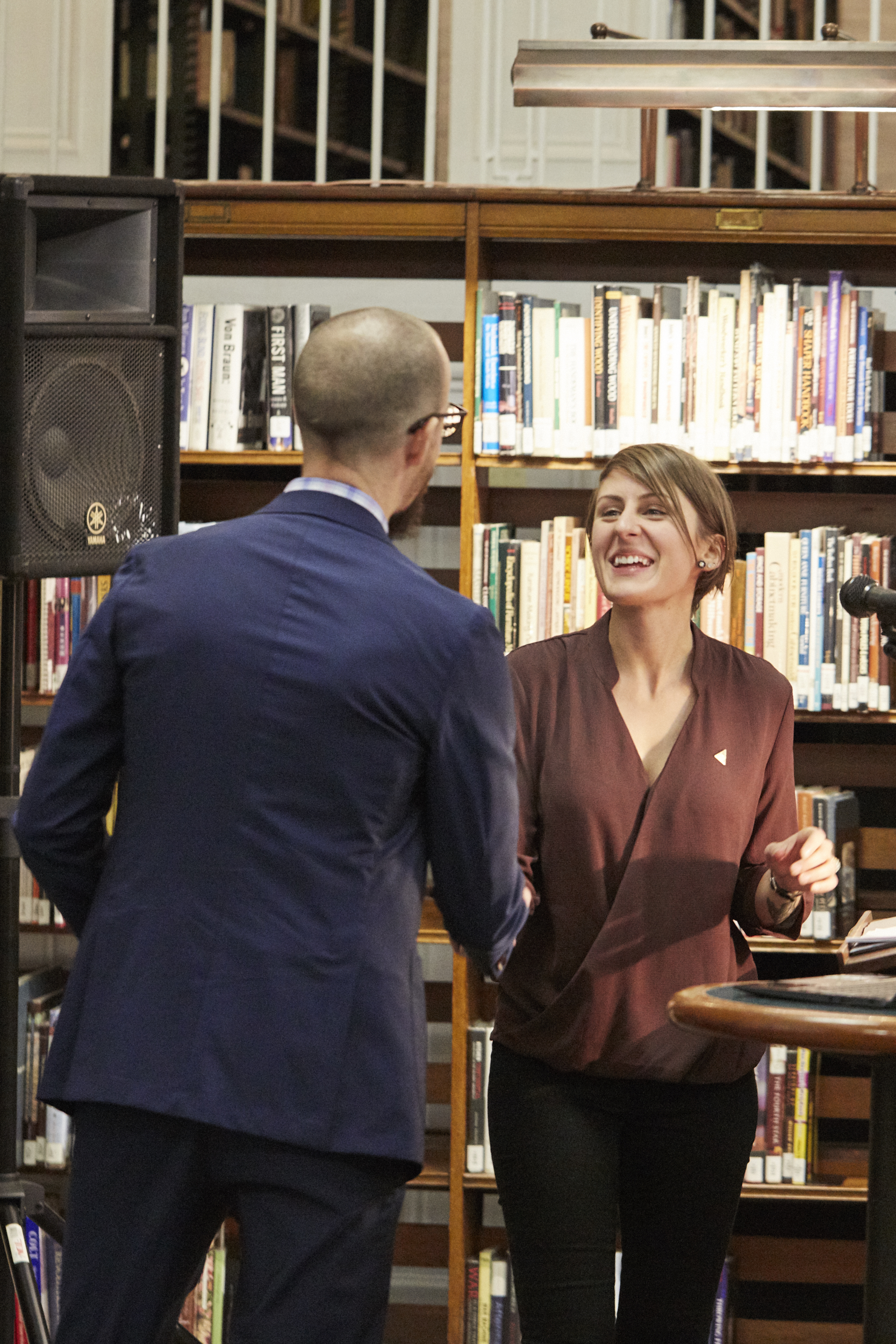
Meeting Recap: Choosing a Clock: Regulation, Cosmopolitanism and Humbuggery
Professor Kevin Birth, Department of Anthropology, Queens College, City University of New York
September 5, 2017
Video recordings of meetings are available to HSNY members.
Imagine if you will, Grand Central Terminal at rush hour on a Friday afternoon. Now, imagine that every train line had clocks that told a different time. What chaos would result! At the September 2017 meeting of the Horological Society of New York, Professor Kevin Birth discussed the history manipulating time for political gain, known as time pluralism.
Birth gave examples from medieval times up to present day. Highlights include English, Austrian, and American history, including the 1859 New York Democratic Party Convention. Over the centuries, hours have changed dramatically from country to country and from season to season, beginning with sundials and even paper hour tables that served to explain what church clock bells meant from many different cultures. Clocks controlled business, the work day, and were also used to predict tides for merchant who moved their wares on rivers and canals.
HSNY thanks Professor Kevin Birth for the fascinating lecture!








Ed Hydeman Named Executive Director for HSNY
HSNY has experienced phenomenal growth over recent years, and the need for a new position to manage behind-the-scenes aspects of the Society has become evident. With this in mind, HSNY's Trustees elected Ed Hydeman as the Society's first Executive Director at the June board meeting. Hydeman's extensive experience in the watch industry, along with serving as HSNY's President for eight years make him perfectly suited to the job. Congratulations, Ed!
Above, Ed Hydeman and Nicholas Manousos at HSNY's 150th Anniversary Gala, March 2016
Meeting Recap: The History of the Tourbillon
Stephen Forsey, Co-founder of Greubel Forsey and CompliTime SA
June 5, 2017
Video recordings of meetings are available to HSNY members.
In his lecture at the June 5th meeting of the Horological Society of New York, Greubel Forsey Co-founder Stephen Forsey detailed the history and functionality of tourbillon watches. Invented in the late 18th century by Abraham-Louis Breguet, the tourbillon has evolved with many enhancements to rate accuracy and reliability. Mr. Forsey pointed out several inventions and improvements made by Greubel Forsey, including their 30 degree inclined tourbillon. Also explained was the scientific methodology that goes into testing tourbillons.
Complimenting the lecture, a selection of Greubel Forsey timepieces were on display, allowing Society members a chance to examine expertly crafted tourbillon mechanisms up close. We thank Mr. Forsey for visiting the Horological Society of New York and delivering such an intriguing lecture.
Submitted by Walter Pangretitsch, Recording Secretary, HSNY

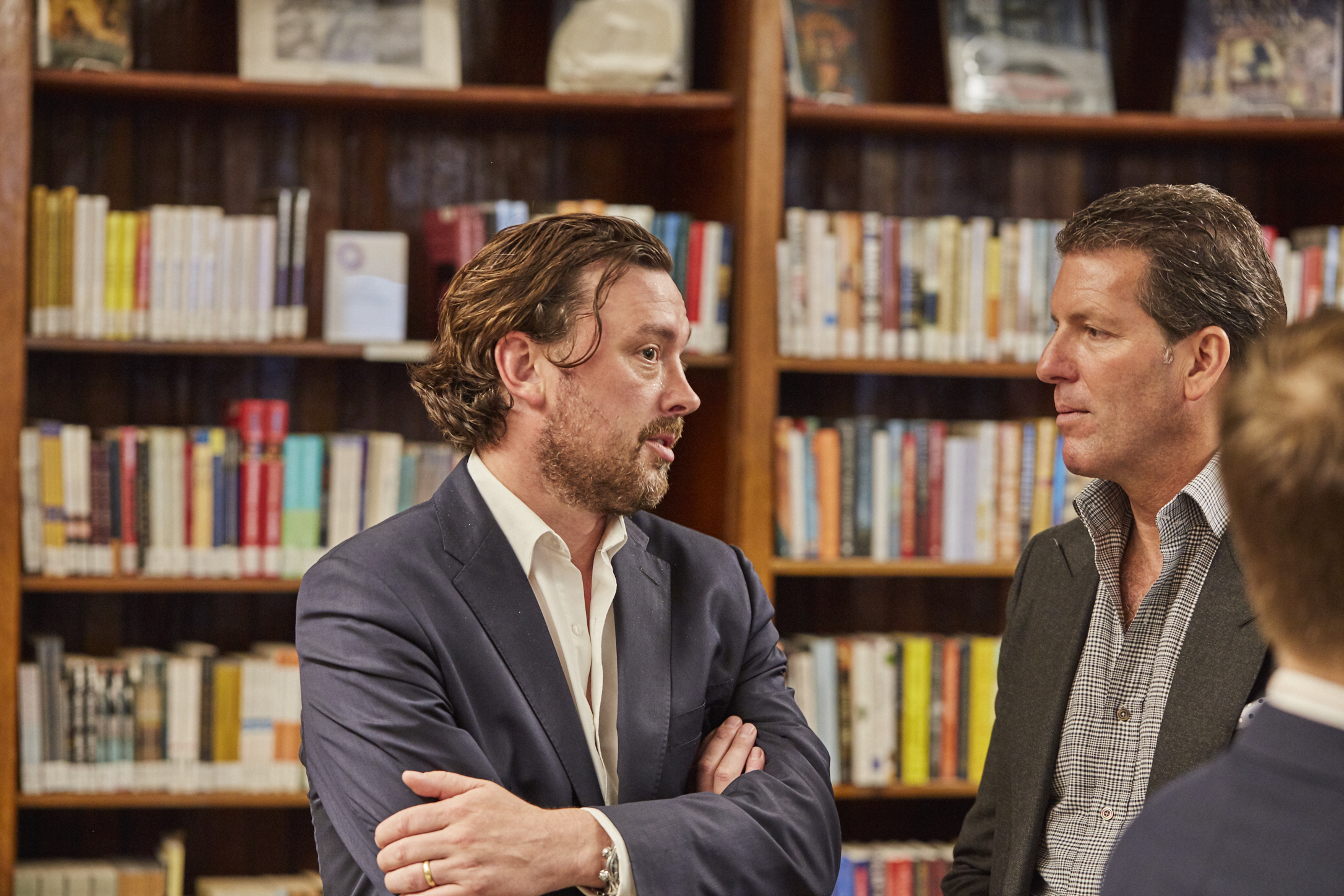







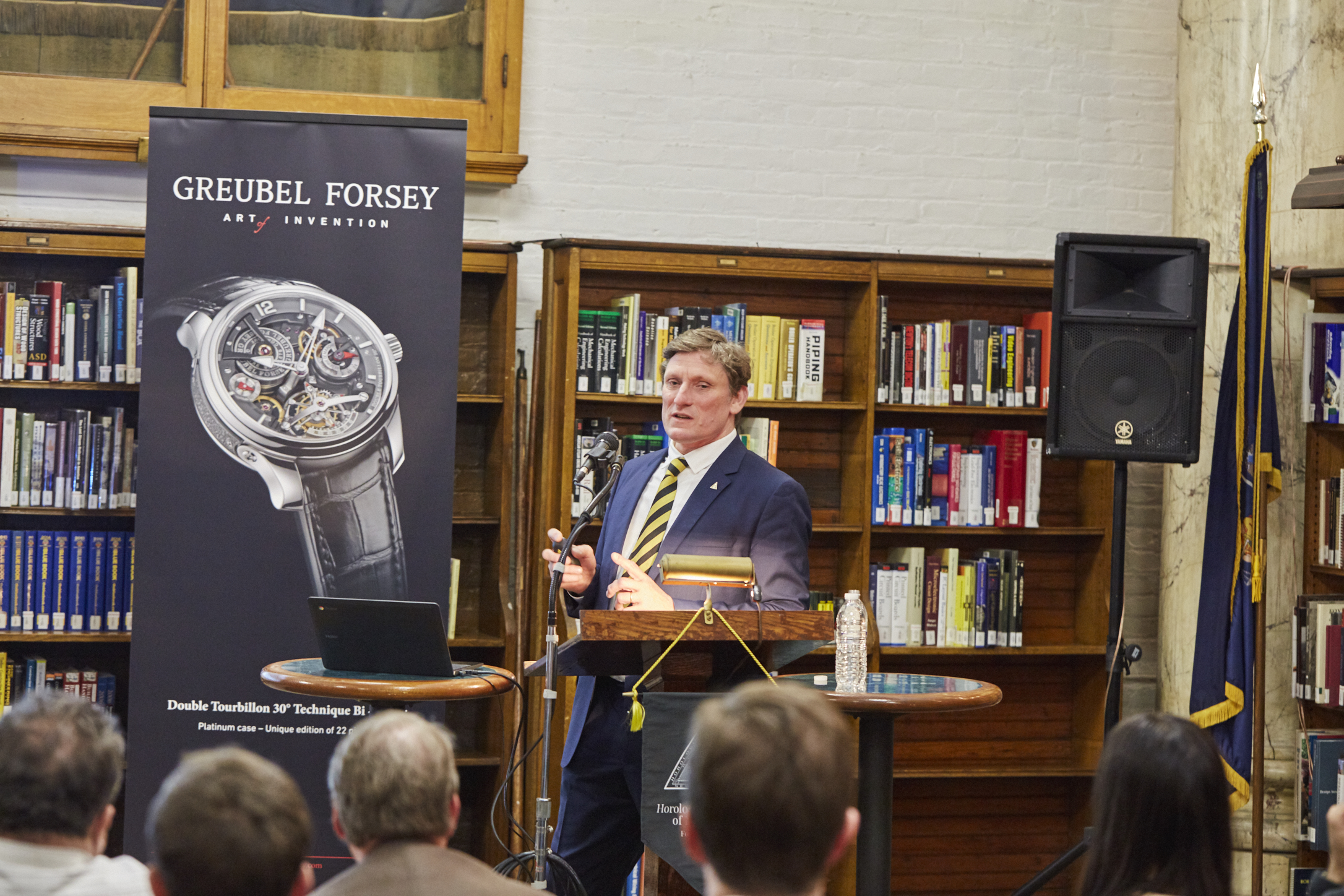



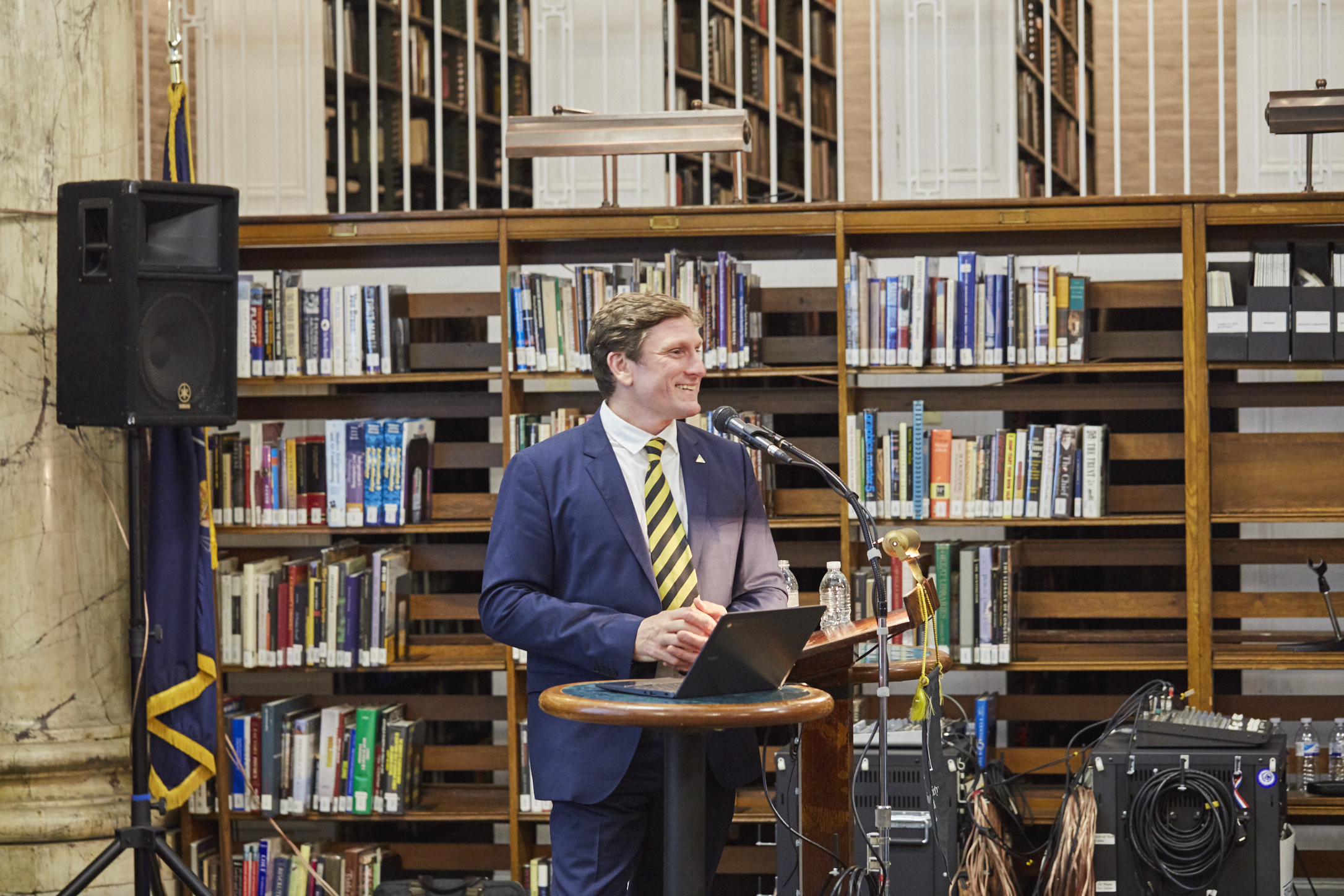




Meeting Recap: Glashütte on Board – 130 Years of Marine Chronometers From Saxony
Ulrike Kranz - Glashütte Original
May 1, 2017
Video recordings of meetings are available to HSNY members.
There is always something new and interesting to learn at HSNY lectures. This was proven once again at the May 1st meeting when Glashütte Original's Ulrike Kranz discussed the history of German marine chronometers. Since the late 19th century and continuing to the present day, watch companies located in the city of Glashütte have produced marine chronometers used by countries worldwide to aid in sea navigation.
Ms. Kranz pointed out that the Glashütte horological industry went through hard times after WWII. Much of their machinery, equipment, and designs were confiscated by Russian forces as part of war reparations. However, they were able to retool most of their factories, recreating designs from memory. It was a remarkable achievement since there was a postwar blockade preventing imports from the west. The new GDR state controlled all factories. Nevertheless, outstanding timepieces continued to be exported.
Kranz explained that after the reunification of Germany the Glashütte Observatory was reopened, and today houses a chronometer testing facility. The Glashütte Observatory also officially certifies the chronometers made by Glashütte Original – the legal successor of the VEB Glashütter Uhrenbetriebe. HSNY thanks Ulrike Kranz, Glashütte Original and the German Watch Museum for the incredible look at German horological history!
Submitted by Walter Pangretitsch, Recording Secretary, HSNY



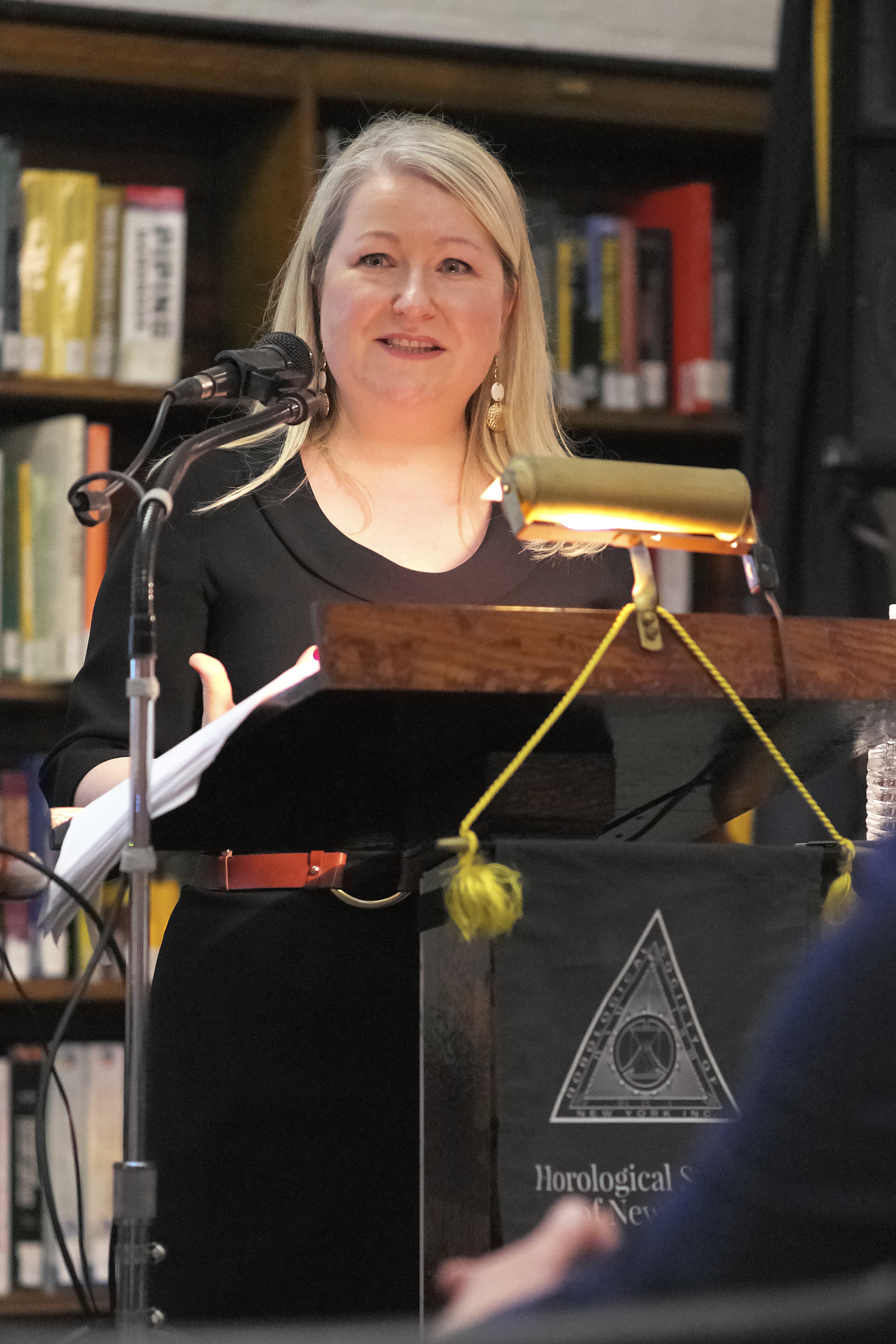




Event Recap: HSNY 2017 Annual Gala & Charity Auction
Video recordings of meetings are available to HSNY members.
On April 3rd, the Horological Society of New York celebrated its 151st anniversary with a gala dinner and charity auction in Midtown Manhattan. Members and guests from across the country gathered to celebrate New York's horological tradition, see the presentation of the Henry B. Fried Scholarship, and bid on a collection of vintage timepieces.
Steve Eagle (HSNY's Director of Education, right) presenting the 2017 Henry B. Fried Scholarship to Justin Shellenberger
The Henry B. Fried Scholarship was established to assist American watchmaking students in their studies at full-time watchmaking schools and was awarded for the first time at the 2017 Gala. HSNY's Director of Education, Steve Eagle, spoke on the merits of horological education and reflected on his time at watchmaking school. Eagle then introduced the 2017 Henry B. Fried Scholarship awardee to the crowd, Justin Shellenberger. Shellenberger is a first year student at the Lititz Watch Technicum in Pennsylvania. In his scholarship application, Shellenberger referenced the impact that the writing of Fried and Daniels made on his watchmaking ambitions.
Nicholas Dawes calling the HSNY 2017 Charity Auction
A collection of vintage timepieces bequeathed to HSNY over forty years ago was auctioned at the 2017 Gala, with proceeds going towards HSNY's newly established endowment fund. Bidding was enthusiastic, with over $30,000 raised from the five lots. The charity auction was made possible by HSNY sponsor Heritage Auctions, and called by Nicholas Dawes of PBS' Antiques Roadshow fame.
The crowd was a diverse mix of watchmakers, clockmakers, collectors, journalists, auctioneers and executives, reflecting the friendship and generosity of the NYC & US watch industry. Plans for HSNY's 2018 Gala are already underway, we are looking forward to seeing you there!


















AWCI Teams up With Richter & Phillips Jewelers to Host an Afternoon at Their Museum Focused on Chronographs
The chronograph is one of the most widely loved complications in the watchmaking world. While it may seem simple to make those secondary hands start, stop, and reset there are many components which need to interact with one another precisely in order for the watch to perform correctly.
On April 22nd, the American Watchmakers-Clockmakers Institute hosts Richter & Phillips Jewelers’ watchmaker Matthew Schloemer, CW21 at their museum near Cincinnati as he lectures on the chronograph mechanism, its history, and its function. Matthew will demonstrate several different chronograph movements and point out key differences between them. He will dive beneath the dial and illustrate from the watchmaker’s perspective all the moving parts and how they interact.
The afternoon event is the first of what AWCI hopes will be many technical events for collectors. Each event will have limited seating and be both social and educational. The $50 registration fee will support watchmaking education and those in attendance will enjoy cocktails and light refreshments, tour the Orville R. Hagans History of Time museum, peruse the library collections, and sit down in their state-of-the-art classroom for a technical presentation.
Limited seats available. Register at awcimuseum.eventbrite.com
7th Annual Madison Avenue Watch Week, May 8-13, 2017
Madison Avenue will once again become the epicenter of haute horlogerie during the 7th Annual Madison Avenue Watch Week. Slated this year for May 8-13, Madison Avenue’s premiere watch retailers and brands will preview their newest and most exceptional timepieces that recently debuted at Baselworld and at SIHH in Switzerland, along with a weeklong immersion into the art of watchmaking.
Open to the public, premier watch brands are welcoming enthusiasts and collectors with special events and offerings during business hours in the participating Madison Avenue stores located between 57th and 86th Streets. For more information, a calendar of events, a map and to request an invitation, visit (new edition of the website coming soon): www.madisonavenuewatchweek.com.
Madison Avenue Watch Week is presented by the Madison Avenue Business Improvement District (BID) and sponsored by The Wall Street Journal. The event is supported by the Horological Society of New York.
Meeting Recap: How to Win (and Sometimes Lose) at Watch Auctions
William Massena - Managing Director of TimeZone.com
March 6, 2017
Video recordings of meetings are available to HSNY members.
The speaker at the March 6th meeting of the Horological Society of New York was William Massena, well-known expert in the field of buying and selling watches. In his second lecture at HSNY, Massena gave practical advise on how to deal with auction houses. Some of the largest firms, such as Phillips, Christies and Sotheby's, handle only high end timepieces. Several others share the growing watch auction market, soliciting bids internationally.
It is up to the buyer to be knowledgable about their potential purchase. Sometimes catalogue descriptions are not sufficient and may be exaggerated. Massena suggests doing your homework, reading a condition report about the watch from the auctioneer and personally inspecting it, if possible. These are valuable tips for collectors and investors who undoubtably drive the auction market. HSNY thanks Massena for his great presentation.
Submitted by Walter Pangretitsch, Recording Secretary, HSNY










